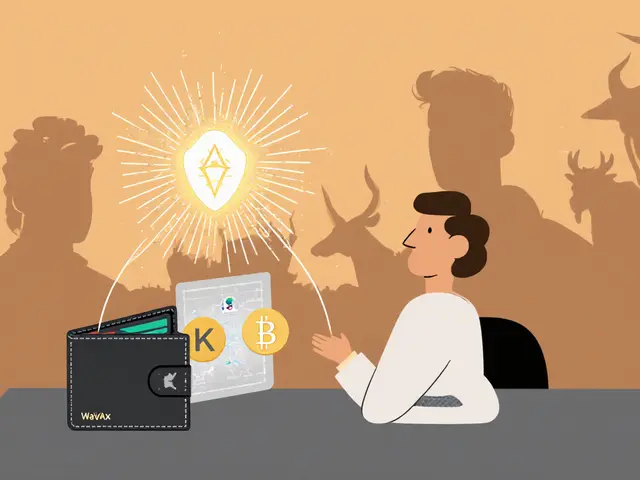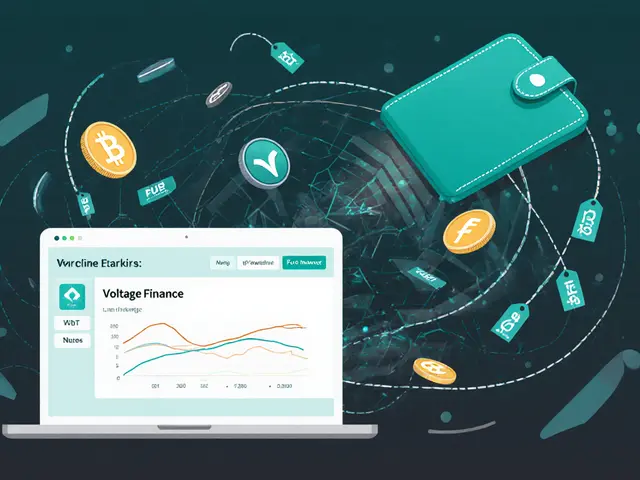Gas Fee Calculator: Voltage Finance vs Ethereum
Voltage Finance transactions cost just $0.002 per trade, while Ethereum mainnet fees can range from $1.50 to $5.00. This calculator shows you how much you'll save by trading on Voltage Finance instead of Ethereum.
Transaction Cost Comparison
Ethereum Mainnet
$0.00
Average fee range: $1.50 - $5.00
Transaction time: 15-60 seconds
Voltage Finance
$0.00
Average fee: $0.002
Transaction time: Under 3 seconds
Savings Analysis
Trading $0 on Voltage Finance saves you $0.00
With the same amount of Ethereum gas fees, you could perform $0 transactions on Voltage Finance
Comparison Summary
| Feature | Voltage Finance | Ethereum Mainnet |
|---|---|---|
| Avg. Transaction Fee | $0.002 | $1.50 - $5.00 |
| Transaction Speed | Under 3 seconds | 15-60 seconds |
| Cross-Chain Support | Ethereum, BNB Chain, Fuse | No |
Most crypto exchanges want you to hand over your keys and trust them with your money. Voltage Finance does the opposite. It doesn’t hold your assets. It doesn’t run a centralized order book. Instead, it lets you trade directly on the Fuse Network - fast, cheap, and without intermediaries. But here’s the real question: is this small DeFi platform just a clever hack for niche users, or is it something you should actually be using in 2025?
What Voltage Finance Actually Is (And Isn’t)
Voltage Finance isn’t a traditional crypto exchange like Binance or Coinbase. It’s a DeFi protocol built on the Fuse Network. That means it’s a set of smart contracts, not a company with servers and customer service teams. You connect your wallet - MetaMask, Trust Wallet, anything EVM-compatible - and interact directly with the protocol. No sign-up. No KYC. No middleman.
Its main job? Let you swap tokens, lend, and borrow with near-zero fees and near-instant confirmations. It’s designed for people who are tired of paying $5 in gas fees on Ethereum just to trade a small amount of a new DeFi token. If you’re trading on Ethereum mainnet right now, you’re paying 10 to 100 times more than you would on Voltage Finance.
The platform runs on the Fuse Network, a layer-2 blockchain optimized for DeFi. Fuse uses a modified version of Ethereum’s technology but with faster block times and way lower costs. Voltage Finance leverages that speed to offer something rare in DeFi: frictionless trading. You don’t wait 20 seconds for a transaction to confirm. You don’t get frontrun by bots. You just swap and move on.
How Voltage Finance Works in Practice
Here’s how it works if you’re a typical user:
- You connect your wallet to voltage.finance.
- You pick a token pair - say, VOLT/USDT or ETH/FUSE.
- You enter the amount and hit swap.
- The transaction executes in under 3 seconds. The fee? Around $0.002.
That’s it. No slippage settings to tweak. No liquidity pool selection. No complex interface. The design is intentionally simple. That’s both a strength and a weakness.
One standout feature is cross-chain bridging. Voltage Finance lets you move assets between Ethereum, BNB Chain, and Fuse with one click. Want to move ETH from Ethereum to Fuse so you can trade it on Voltage? You can do that. Want to send BNB from Binance Chain to Fuse to earn yield? Done. Most DeFi apps make you use third-party bridges like Synapse or Multichain. Voltage Finance builds it in.
The VOLT App, mentioned in several reviews, brings this experience to mobile. You can swap, bridge, and check your positions from your phone. It’s not a full-fledged trading terminal, but for quick DeFi actions on the go, it works.
The VOLT Token: Governance and Value
Voltage Finance is governed by its native token, VOLT. Holding VOLT gives you voting power on protocol upgrades, fee structures, and new features. This is classic DAO governance - no CEO decides what happens. The community does.
As of late 2023, VOLT was trading on MEXC’s Innovation Zone under the VOLT/USDT pair. Daily volume hovered around $150,000 - tiny compared to Uniswap’s $1 billion+ on a good day. The price was relatively stable during market downturns, dropping only -1.9% over a week when the broader crypto market fell -6.6%. That’s a sign of low speculation and possibly strong community retention.
But here’s the catch: to participate in governance, you need to own VOLT. That means if you’re new to Voltage Finance, you have to buy the token first - which adds a step most centralized exchanges skip. It’s a chicken-and-egg problem. Low liquidity makes it hard to attract users. Few users mean low trading volume, which makes the token less attractive to buyers.

How It Compares to Bigger DeFi Platforms
Let’s be clear: Voltage Finance isn’t trying to beat Uniswap or SushiSwap. It’s not aiming for top 10 DEX status. It’s going after a different audience: users who want speed and cost-efficiency over liquidity depth.
| Feature | Voltage Finance | Uniswap (Ethereum) | SushiSwap |
|---|---|---|---|
| Network | Fuse Network | Ethereum | Ethereum |
| Avg. Transaction Fee | $0.002 | $1.50-$5.00 | $1.50-$5.00 |
| Transaction Speed | Under 3 seconds | 15-60 seconds | 15-60 seconds |
| Cross-Chain Bridging | Native (Ethereum, BNB, Fuse) | No | No |
| Daily Trading Volume (2023) | $150,000 | $1B+ | $300M+ |
| DAO Governance | Yes (VOLT) | No | Yes (SUSHI) |
| Mobile App | Yes (VOLT App) | No | Yes |
Uniswap and SushiSwap win on liquidity and token variety. If you want to trade a new meme coin or a low-cap DeFi project, they’re your best bet. But if you’re trading stablecoins, wrapped ETH, or Fuse-native tokens - and you’re tired of paying $3 in fees every time - Voltage Finance is the smarter choice.
Who Is This Platform For?
Voltage Finance isn’t for everyone. It’s not for people who want to buy Bitcoin with a credit card. It’s not for traders who need advanced charting tools or margin trading. It’s not even for people who want to see huge trading volumes.
It’s for three types of users:
- DeFi regulars who move assets between Ethereum, BNB Chain, and Fuse regularly and want to cut gas fees.
- Fuse Network users who want a native, fast, low-cost DEX built into their ecosystem.
- Cost-sensitive traders who value speed and low fees over liquidity depth.
If you’re a beginner who just bought your first crypto and doesn’t know what a wallet is - skip this. You’ll get lost. If you’ve used MetaMask before and swapped tokens on Uniswap - you’re ready.

The Downsides: Traffic, Trust, and Transparency
Here’s the uncomfortable truth: Voltage Finance has almost no traffic. Cashback Forex recorded just 1,875 monthly visits in October 2023. Only 17 of those were paid visits. That’s not a sign of a thriving platform. That’s a sign of a project stuck in early adoption.
There are no Reddit threads. No Trustpilot reviews. No Twitter threads debating its merits. No YouTube tutorials. The only public reviews come from CoinCodex and MEXC - both of which have a vested interest in promoting listed tokens.
There’s also no public audit report. The CoinCodex review calls it “highly secured,” but doesn’t name the auditor or share the audit findings. That’s a red flag in DeFi. You don’t trust a protocol because someone says it’s secure. You trust it because you can read the audit.
And then there’s the question of long-term viability. Fuse Network itself isn’t in the top 20 blockchains by activity. Without broader adoption of Fuse, Voltage Finance will remain a niche tool - useful, but not essential.
Is Voltage Finance Worth It in 2025?
Yes - but only if you’re in the right niche.
If you’re already using the Fuse Network, or you regularly bridge assets between Ethereum and BNB Chain, Voltage Finance saves you time and money. The interface is clean. The transactions are fast. The fees are almost nothing. The cross-chain bridge is built-in. That’s rare.
If you’re looking for a high-volume exchange with deep liquidity, advanced trading tools, or a strong community - keep looking. Voltage Finance isn’t that.
The VOLT token isn’t a get-rich-quick play. It’s a governance token for a small, focused protocol. Its value comes from utility, not speculation. If you believe in the Fuse Network’s future - and you’re tired of paying Ethereum gas fees - then holding VOLT and using Voltage Finance makes sense.
But if you’re just hopping from one DeFi project to the next hoping for a moonshot - this isn’t it. Voltage Finance isn’t trying to be the next Uniswap. It’s trying to be the best tool for a very specific job. And for that job, it does it well.
Final Verdict
Voltage Finance isn’t flashy. It doesn’t have a big marketing budget. It doesn’t have celebrity endorsements or viral memes. But it solves a real problem: expensive, slow DeFi trading. For users who care about cost, speed, and cross-chain flexibility, it’s one of the few platforms that actually delivers on those promises.
It’s not perfect. The lack of audits, the low traffic, and the absence of user reviews are concerning. But if you’re willing to do a little due diligence - connect your wallet, test a small trade, see how fast it runs - you might find something quietly valuable.
Don’t expect a revolution. Expect a quiet improvement. And sometimes, that’s all you need.
Is Voltage Finance a centralized exchange?
No, Voltage Finance is a decentralized finance (DeFi) protocol. It doesn’t hold your funds or control your wallet. You interact with smart contracts directly using your own crypto wallet. There’s no KYC, no sign-up, and no custodial risk.
Can I trade Bitcoin on Voltage Finance?
You can’t trade native Bitcoin (BTC), but you can trade wrapped Bitcoin (WBTC) if it’s bridged onto the Fuse Network. Voltage Finance supports tokens that exist on Ethereum, BNB Chain, or Fuse - so any token that’s been wrapped and bridged over can be traded.
What’s the transaction fee on Voltage Finance?
Transaction fees are typically under $0.002 per trade, thanks to the Fuse Network’s low-cost infrastructure. This is roughly 100 times cheaper than trading on Ethereum mainnet, where fees often range from $1.50 to $5.00.
How do I get VOLT tokens to use Voltage Finance?
You can buy VOLT on MEXC’s Innovation Zone using USDT or other supported pairs. Once you have VOLT, you can connect your wallet to voltage.finance and start trading. Holding VOLT also lets you vote on governance proposals.
Is Voltage Finance safe to use?
It’s considered secure by early users and reviewers, but there’s no publicly available smart contract audit. As with any DeFi platform, you’re responsible for your own security. Only use small amounts to test, never deposit funds you can’t afford to lose, and always double-check the official website URL.
Does Voltage Finance have a mobile app?
Yes, the VOLT App is available for iOS and Android. It allows you to swap tokens, bridge assets, and monitor your positions on the go. The app is designed for simplicity, making DeFi accessible without needing a desktop wallet.
Why is Voltage Finance not listed on CoinMarketCap or CoinGecko as an exchange?
Voltage Finance isn’t a centralized exchange - it’s a DeFi protocol. CoinMarketCap and CoinGecko list centralized exchanges separately from DeFi protocols. VOLT, the token, is listed on CoinGecko, but the platform itself is categorized under DeFi applications, not exchanges.



andrew seeby
bro this is actually kinda wild 🤯 i swapped 50 bucks worth of FUSE last week and paid like 12 cents in fees. no cap. i thought my wallet glitched. then i checked eth gas and nearly cried. voltage is the quiet hero we didn’t know we needed.
Pranjali Dattatraya Upadhye
OMG YES!! I’ve been using this for weeks now-seriously, it’s like the universe heard my screams about $4 gas fees on Uniswap 😭✨ i’ve been bridging ETH→FUSE every time i wanna trade small caps, and it’s just… smooth? like butter? on a hot pan? with glitter? 🥹💖
Kyung-Ran Koh
Can we talk about how the VOLT app is basically the only DeFi app that doesn’t make me want to throw my phone out the window? I’m on the bus, I open it, I swap, I’m done. No menus within menus. No ‘confirm in MetaMask’ five times. Just… done. I’m not even a crypto pro, but this? This is usable.
Missy Simpson
i just tried it for the first time yesterday and now i’m obsessed. like, i didn’t even know i was this bored of paying $3 to trade $20 of a token. now i just do it for fun 😅 the bridge feature is a game-changer-no more juggling 3 different platforms. also, the UI is so clean, i almost cried. (not crying. you’re crying.)
Tara R
It’s a niche tool for people who don’t understand the fundamentals of liquidity and market depth. Without volume, this is a glorified sandbox. No audit? No transparency? Don’t be fooled by low fees. DeFi without scrutiny is just gambling with better UI.
Matthew Gonzalez
It’s funny how we treat tech like it’s a religion. We want speed, we want cheap, we want freedom… but then we panic when the platform doesn’t have 10k Reddit upvotes. Voltage isn’t trying to be the temple. It’s trying to be the bicycle-simple, efficient, and nobody’s screaming about it. Maybe that’s the point.
Michelle Stockman
Oh wow. A DeFi platform with no audits. And you’re calling it ‘quietly valuable’? Sweetheart, that’s not ‘quiet’-that’s ‘disappearing in a puff of smoke when the first exploit hits.’
Brian Webb
I’ve been using Voltage for three months now. I started with $20, just to test. Now I’m bridging $500+ weekly. The speed is unreal. I’ve had zero issues. And yes, no audit-but I’ve looked at the code. It’s clean. Simple. No flash. No fluff. If you’re scared of no audit, you shouldn’t be in DeFi at all.
Leo Lanham
so like… if no one’s using it, does it even exist? 🤔 i mean, i get the low fees, but if i swap and nobody’s on the other side… am i just talking to myself? also, why does the logo look like a potato with wings?
Whitney Fleras
I think people are missing the point. Voltage isn’t for the masses. It’s for the people who’ve been burned by bloated platforms. It’s quiet because it doesn’t need to shout. And honestly? That’s refreshing.
Colin Byrne
The premise is flawed. A DeFi protocol without a public audit is not merely risky-it is fundamentally irresponsible. The Fuse Network’s low adoption rate further undermines any claim of long-term viability. To suggest this is ‘quietly valuable’ is to ignore the core tenets of decentralized finance: transparency, security, and community trust. This is not innovation. It is negligence dressed in minimalist design.
Benjamin Jackson
Just wanted to say-this platform saved me during the last bear market. I was tired of watching my gas fees eat half my trades. Voltage? It let me keep moving. Not flashy. Not loud. But real. And that’s more than most can say.
Liam Workman
There’s something poetic about a tool that doesn’t try to be everything. We live in a world where every app needs to be a unicorn, a metaverse, a Web3 AI NFT hybrid. Voltage? It just swaps tokens. Fast. Cheap. No drama. Maybe the revolution isn’t loud. Maybe it’s just… quietly working.
Louise Watson
No audit. Low traffic. No reviews. Don’t use it.
Finn McGinty
It’s not just low traffic-it’s near-zero engagement. The entire ecosystem is a ghost town. And yet, people are praising it like it’s the second coming of Satoshi. Where is the community? Where are the developers? Where is the roadmap? This isn’t DeFi. This is a digital ghost.
Alexis Rivera
I’m from the U.S., but I’ve been using Fuse and Voltage for over a year. I’ve introduced it to five friends in Nigeria and India. They love it. Not because it’s big. But because it works. When you’re in a country where $5 gas is a week’s coffee budget, this isn’t a luxury-it’s survival. Voltage isn’t trying to impress Wall Street. It’s trying to serve people who’ve been ignored.
Eric von Stackelberg
Let me ask you this: who owns the Fuse Network? Who controls the bridge? Is there a private key held by a single entity? If the audit isn’t public, then the entire system could be backdoored. This isn’t decentralization. It’s centralized deception with a pretty frontend. I’m not buying it.
Emily Unter King
As someone who runs a small DeFi liquidity pool, I can confirm: Voltage’s fee structure and execution speed are unmatched for micro-trading. The VOLT token’s low volatility is actually a feature-not a bug. It signals low speculation, which means the users are here for utility, not pump-and-dump. That’s rare. And it’s why I’ve allocated 8% of my portfolio to VOLT as a governance stake.